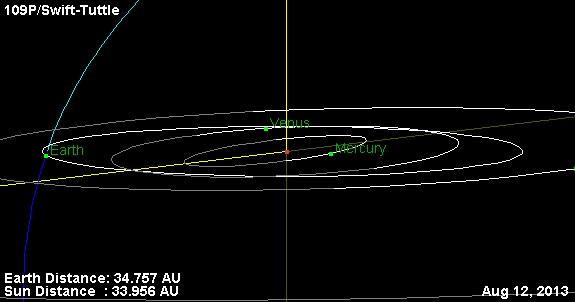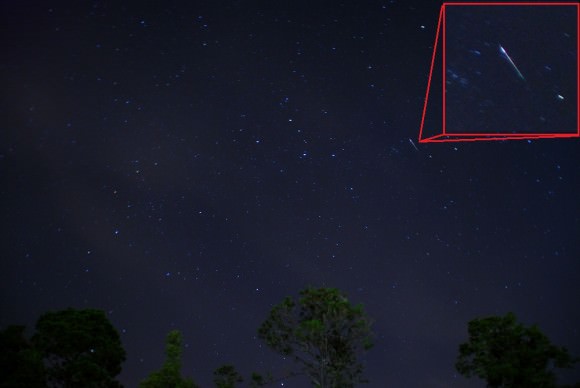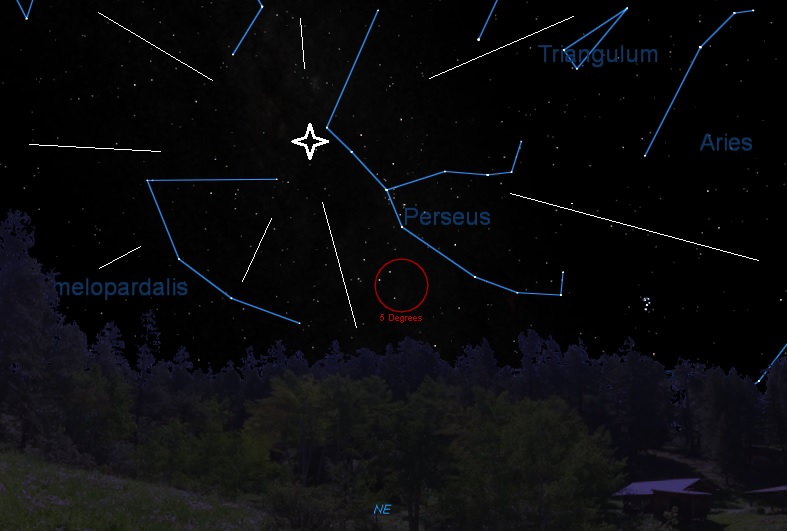Get set for the meteoritic grand finale of summer.
Northern hemisphere summer that is. As we head into August, our gaze turns towards that “Old Faithful” of meteor showers, the Perseids. Though summer is mostly behind us now, “meteor shower season” is about to get underway in earnest.
Pronounced “Pur-SEE-ids,” this shower falls around the second week of August, just before school goes back in for most folks. This time of year also finds many the residents of the northern hemisphere out camping and away from light-polluted suburban skies.
This year also offers a special treat, as the Moon will be safely out of the sky during key observation times. The Moon reaches New phase on August 6th at 5:51 PM EDT/ 9:51 Universal Time (UT) and will be a 32% illuminated waxing crescent around the anticipated peak for the Perseid meteors on August 12th. And speaking of which, the Perseids are infamous for presenting a double-fisted twin peak in activity. This year, the first climax for the shower is predicted for around 13:00 UT on August 12th, favoring Hawaii and the North American west coast, and the second peak is set to arrive 13 hours later at 02:00 UT, favoring Europe & Africa.
Nodal crossing for the Perseid stream and Earth’s orbit sits right around 18:00 to 21:00 UT on August 12th for 2013. The shower derives its name from the constellation Perseus, and has a radiant located near Gamma Persei at right ascension 3 hours 4 minutes and a declination of +58 degrees. Atmospheric velocities for the Perseids are on the high end as meteor showers go, at 59km/sec.
Of course, like with any meteor shower, it’s worth starting to watch a few days prior to the peak date. Although meteor streams like the Perseids have been modeled and mapped over the years, there are still lots of surprises out there. Plus, starting an early vigil is insurance that you at least catch some action in the event that you’re clouded out on game day! Like we mentioned in last week’s post on the Delta Aquarids, the Perseids are already active, spanning a season from July 17th to August 24th.
The Zenithal Hourly Rate for the Perseids is generally between 60-100 meteors. The ZHR is the number of meteors you could expect to see during optimal conditions under dark skies with the radiant directly overhead. Rates were enhanced back in the 1990’s, and 2004 saw a ZHR of 200.

The source of the Perseids is comet 109P/Swift-Tuttle. Discovered on July 16th-19th, 1862 by astronomers Lewis Swift & Horace Tuttle, Swift-Tuttle is on a 133.3 year orbit and last passed through the inner solar system in late 1992. This comet will once again grace our skies in early 2126 AD.
The Perseids are also sometimes referred to as the “tears of St Lawrence,” after the Catholic saint who was martyred on August 10th, 258 AD. The Perseids have been noted by Chinese astronomers as far back as 36 AD, when it was recorded that “more than 100 meteors flew thither in the morning.” The annual nature of the shower was first described by Belgian astronomer Adolphe Quételet in 1835.
Enhanced rates for the Perseids marked the return of comet Swift-Tuttle in the 1990s. Recent years have seen rates as reported by the International Meteor Organization at a ZHR=175(2009), 91(2010), 58(2011), & a resurgence of a ZHR=122 last year.
Just what will 2013 bring? There’s one truism in meteor observing—you definitely won’t see anything if you do not get out and observe. Meteor shower observing requires no equipment, just clear skies and patience. Watch in the early hours before dawn, when the rates are highest. Meteors can occasionally be seen before midnight, but are marked by lower rates and slow, stately trains across the sky. Some suggest that best viewing is at a 45 degree angle away from the radiant, but we maintain that meteors can appear anywhere in the sky. Pair up with a friend or two and watch in opposite directions to increase your meteor-spotting chances.
We also like to keep a set of binoculars handy to examine those smoke trains left by bright fireballs that may persist seconds after streaking across the sky.
And speaking of which, there has also been some spirited discussion over the past week as to whether or not the Perseids produce more fireballs than any other shower. I certainly remember seeing several memorable fireballs from this shower over the years, although the Geminids, Leonids and Taurids can be just spectacular on active years. The stated r value of the Perseids is one of the lowest at 2.2, suggesting a statistically high percentage of fireballs.
And in the realm of the strange and the curious, here are just a few phenomena to watch/listen for on your Perseid vigil;
– Can you “hear” meteors? Science says that sounds shouldn’t carry through the tenuous atmosphere above 50 kilometres up, and yet reports of audible meteors as a hiss or crackle persist. Is this an eye-brain illusion? Researchers in 1988 actually studied this phenomenon, which is also sometimes reported during displays of aurora. If there’s anything to it, the culprit may be the localized generation of localized electrophonic noises generated by Extra/Very Low Frequency electromagnetic radiation.
– Can meteor streaks appear colored? Green is often the top reported hue.
– Can meteors appear to “corkscrew” during their trajectory, or is this an illusion?

Wide-field photography is definitely a viable option during meteor showers. Just remember to bring extra charged batteries, as long exposure times will drain modern DSLRs in a hurry!
And did you know: you can even “listen” to meteor pings on an FM radio or portable TV? This is a great “rain check” option!
And there’s still real science to be done in the world of meteor shower studies. The International Meteor Organization welcomes counts from volunteers… and be sure to Tweet those Perseid sightings to #Meteorwatch.
Also be sure to check out the UK Meteor Observation Network, which has just launched their live site with streaming images of meteors as they are recorded.
Good luck, clear skies, and let the late 2013 meteor shower season begin!
-And be sure to post those Perseid pics to the Flickr forum on Universe Today… we’ll be doing photo essay roundups from observers around the world!


Can you “hear” meteors? – YES! I viewed the great 2001 Leonid meteor storm from high in the nearby coastal mountains, 75 miles north of S.F. My usual solitary perch grew to 8 people as word of the storm went out. We stayed up all night and at one point counted more than 1,000 meteors per hour! One feller had been working all day and wanted to lay down. I got a blue plastic tarp out of my truck for him. He laid down on the cold asphalt. THEN, right after the next couple of big fireballs, he shouted, “Hey! Did you hear that?” It was VERY cold that night with a high static charge in the air. Somehow.. that blue tarp amplified the sound of the meteors! Getting down close to the tarp, we all heard it…. a very subtle kind of crackling, hissing Doppler shifting electric sound!
Thanks, there’s lots of support for audible meteors, including the study linked to in the article. I remember a seeing dramatic Perseid accompanied by a distinct “hiss” short after its train faded out!
If the sound was perceived immediately during or after the visual sighting of the meteor then it had nothing to do with the meteor (or THAT meteor). It takes the sound a finite time to reach us and depending on the altitude it burns up that could be upwards of 3 minutes or more. If you watch the Youtube videos taken live in the minutes following the sighting of the Chelyabinsk, Russia meteor (small asteroid) you’ll notice that something like 3 or minutes elapse from the sighting to the sonic booms. That one was ~ 12 miles up when it began to burn up.
Say “pur-SEE-ids” if you like, but my dictionaries unanimously go for “PUR-se-ids”.
how about percy ids,:)
I will be at the beach from the 11th to the afternoon on the 12th. I am confused about the time to watch on the 12th – would the dawn on the 12th be peak for the east coast of North America (New England)? Or would the evening on the 12th be better to dawn the 13th?
Hi Karen, early morning on the 12th will be best for two reasons. First, the moon sets after 11 so the sky will be darker after that (the moon will be between Spica, a brilliant blue star below and Saturn just above – the star will be the one that twinkles, really). Second, there are always more meteors just before sunrise because this part of earth is facing in the direction that earth is travelling around the sun, and plowing into the dust specks in space that become meteors when they burn up in our atmosphere
Hi! Me again, I was in Fort Meyers Beach,’FL last October (during the Orionid time) and I saw a Very bright, a Very close flash (bright burst of light) and what appeared to be a short quick ‘tail’ – could That have been a fireball?
Hi Karen. Yes, most likely was a short-lived fireball. Those can even be seen at any time of night, any time of the year randomly rather than part of a shower’s peak activity.
i live in the colorado rockies at near 9000 ft (awesome viewing) but have been as high as 12000 ft (mind-blowing viewing) even “non-event” nights you will see something as well as a number of drifting satellites
please help me to be sure of the date and time for me to observe i live in southern calif. USA Oak Hills, CA 92344 thanks for your help kathy
If there are bolides or fireballs on the night of Aug. 11/12 as perseids meteor shower peaks let’s not hope it would not be like the one in chelyabinsk in russia and what if it’s 70 or more meteors per hour?
http://goo.gl/xD5w1t
The early morning hours of Monday August 12th before dawn should see the peak of the Perseid meteors for the US West Coast. Keep in mind, the predicted peak can arrive several hours early or late, and the Perseids are already active this weekend. You may catch a few prior to local midnite, but odds are better in the AM when an observer is turned forward into the stream. Hope this helps!
I would like to know if any of these meteors ever hit the earth?
Is it possible while watching, to also watch for an impact in your area of viewing?
I live in BIG SKY Montana and am planning on driving up in to the mountains to a location we call Horseman’s Flats which is a wide open area facing the North-east from the road. There will almost NO lights except from one or two ranches miles away. I would love to be able to find an impact crater and recover a meteorite.
Does anyone think this might be possible or are these so small that they all burn up before hitting the ground?
Hi! I live about 20 minutes north of Salt Lake City, with 5 minute access to mountains, and I am wondering what time would be best to check it ( the Perseids meteor shower) out and which direction to face. I will be high above the Salt Lake Valley, will that light pollution obscure my view, in other words, should I face the mountain when laying down? In 2000, I observed this meteor shower from Virgin Utah, near Zion Nat’l Park. It blew my mind! It seemed I could reach out and touch them as they blew by. It even seemed like they were falling onto the other side of the mesa, because it left such a bright trail, it looked like it was on fire.